Late in 1974, with deadline to end Adobe Creek Lodge's commercial
operation just over a year off, Bellucci offered the town a compromise,
the first of several attempts to make over the business into a
sort of non-profit cooperatively owned venture. He had been against
the non-profit route, he said, as he had invested considerable
capital in the business, but now there seemed no other way out.
In 1976 he did make the club non-profit, leasing the land and
club to the members while living on the property himself. In 1978
there appeared questions by members as to what use was made of
their money. Adobe Creek Lodge continued operation under a conditional
use permit until matters came to a head. At two meetings of the
town council, Bellucci did not appear. Another was scheduled for
late September 1978, with a public hearing on the lodge's status.
Now, Bellucci was proposing outright sale of the property to the
lodge's members, excepting the parcel with his home, for $2 million
dollars. The alternatives, he said in a letter to club members,
were to change the zoning ordinance - there seemed little chance
of that - or, again, sell the property to residential developers
for subdivision. However, late in 1978 the town revoked Bellucci's
conditional use permit, and Adobe Creek Lodge ceased commercial
operation in January, 1979.
Over the next six years Bellucci made several proposals for re-opening.
In 1979 he retained Pangea Coporation of Los Altos to submit a
use permit to the town planning commission, remodel buildings,
and start a supper club. The planning commission approved Bellucci's
latest proposal, but apparently the town council did not. In 1980
Bellucci offered the property to the town itself, which would
finance the purchase with revenue bonds. In September, 1980, however,
a consultant advised the town that operation of Adobe Creek Lodge
as a private club, now without a restaurant, was of doubtful value,
and the town would not qualify for tax-exempt status.
Another deal had fallen through. The property deteriorated. On
September 13, 1980 Bellucci endured the ignominy of selling the
lodge's movable property at auction. "A throng of restaurant
owners and barkeeps," said the Town Crier, "bid on the
collection of restaurant furnishings, kitchen equipment, garden
furniture, tennis nets, and other relics of the club's heyday."
Los Altos Hills administrator Karen Jost recalls Bellucci from
this period, or possibly afterwards. He would come to the town
on a motor scooter, in a terry bathrobe, saying that he didn't
have money because the town had taken it all.
In June, 1984 Bellucci offered another proposal, this being for
a "family park," in which an anticipated 1,750 ownership
interests would be sold. The resultant private park, to include
open space, tennis courts, a tennis center, swimming pools, and
a "youth activities center," would be for day use only
with no food service. That proposal requiring an environmental
impact report, Bellucci followed in November, 1984 with an interim
use permit application to form a 300-member non-profit club. As
this would just reinstate a long-established use of the property,
no EIR would be necessary. Once the ownership-interest plan was
processed, he would abandon the interim proposal. In 1985, with
Adobe Creek Lodge still closed, Bellucci withdrew the latter proposal.
Naturally, Bellucci still faced resistance. After polling Los
Altos Hills council members informally, he found that he could
not muster a majority to approve the 1,750-member plan.
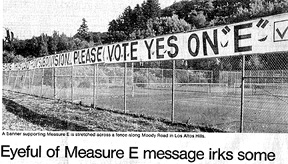
Bellucci put the property up for sale in June, 1985. He still
tried one last gamble to re-open Adobe Creek Lodge commercially.
By August he had gathered signatures on a petition for a ballot
initiative to affect all 15-acre sites zoned for recreational
use in Los Altos Hills. His proposal, which appeared on the November,
1985 ballot as Measure E, would change the town zoning to allow
recreational use of Adobe Creek Lodge without the original conditional
use permit. Predictably, Measure E was controversial, even bitter.
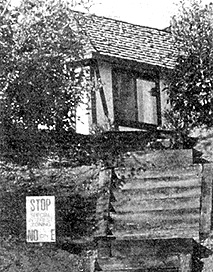 Bellucci
and his supporters touted Measure E in environmental terms, saying
it would save open space; opponents said it was only to save Bellucci's
hide. There being no businesses in Los Altos Hills, Bellucci asked
stores in Los Altos to display "Yes on E" signs. Those
who did heard from Los Altos Hills opponents of E. Bellucci charged
"Gestapo tactics." Measure E opponents accused proponents
of pulling down "No on E" signs, and cutting away trees
by Adobe Creek Lodge to display "Yes on E" signs more
prominently. Predictably, Measure E was resoundingly defeated,
782 Yes to 1,312 No.
Bellucci
and his supporters touted Measure E in environmental terms, saying
it would save open space; opponents said it was only to save Bellucci's
hide. There being no businesses in Los Altos Hills, Bellucci asked
stores in Los Altos to display "Yes on E" signs. Those
who did heard from Los Altos Hills opponents of E. Bellucci charged
"Gestapo tactics." Measure E opponents accused proponents
of pulling down "No on E" signs, and cutting away trees
by Adobe Creek Lodge to display "Yes on E" signs more
prominently. Predictably, Measure E was resoundingly defeated,
782 Yes to 1,312 No.
Bellucci's last plan was in 1987, when he proposed a senior citizens
facility, like the Sequoias in Portola Valley. A portion of the
property ended up subdivided with one-acre lots.
Bellucci continued to live at Adobe Creek Lodge until early 1993,
by one account. He moved to between Santa Cruz and Capitola, taking
up residence on Pleasure Point Drive, and operated Bellucci's
House of Poker in Live Oak.
 On
the morning of Friday, June 11th, a 911 operator got a call for
help from Bellucci. Medics found him at his house savagely beaten
by a blunt instrument. He had head injuries, and torso and arm
fractures. Taken to Dominican Santa Cruz Hospital, he died during
surgery. Like so much about Bellucci, his violent death causes
speculation. Was he the victim of a random attack? Did he have
mob connections? Was he threatened because he owed money? Did
his attackers go too far and panic, leaving him to die? In any
case, his murder is unsolved and probably always will be. He left
several ex-wives and children.
On
the morning of Friday, June 11th, a 911 operator got a call for
help from Bellucci. Medics found him at his house savagely beaten
by a blunt instrument. He had head injuries, and torso and arm
fractures. Taken to Dominican Santa Cruz Hospital, he died during
surgery. Like so much about Bellucci, his violent death causes
speculation. Was he the victim of a random attack? Did he have
mob connections? Was he threatened because he owed money? Did
his attackers go too far and panic, leaving him to die? In any
case, his murder is unsolved and probably always will be. He left
several ex-wives and children.
Adobe Creek Lodge passed from Bellucci's ownership to a Savings
and Loan's. After that went bankrupt, the property passed to the
Resolution Trust Company. In 1994 Robert Wayman, chief financial
officer of Hewlett-Packard, and his wife Susan bought the buildings
and six surrounding acres.
Adobe Creek Lodge's original buildings had deteriorated. Bob Wayman
remembers a lizard poking up through a hole in the main house's
floor. Wayman, who of course knew quite a lot about electronics
and communications, also found the property had been equipped
with 200 telephone lines. Again, one can speculate about Bellucci.
Had he been running a bookmaking operation?
The Waymans hired the architectural firm Moyer Associates, lead
architect Dave Miller. Landscape architect was Thomas Klope of
Los Altos. Interior designer was Michelle Stojoanovich, of Room
With a View Interiors, Los Gatos. The Waymans consulted the archives
of Los Altos's history museum, and recycled or reproduced original
paneling, grilles, doors, cabinets, and fixtures. The original
designs were retained as much as possible, and added to in good
taste.
The Waymans added a second story to the Tally Ho Club, which was
remodeled as a guest house. Landscape architect Klope designed
a stone walkway to frame the large back lawn and connect with
the casino and the new swimming pool. I venture that Milton Haas
would approve of the Waymans' work.
Just left of the main entrance off Moody Road is a creek with
a stone bridge. If this looks familiar, that's because it's the
logo of the LAHHS newsletter. Courtesy Ralston
Independent Works
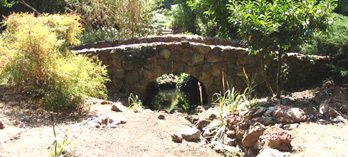
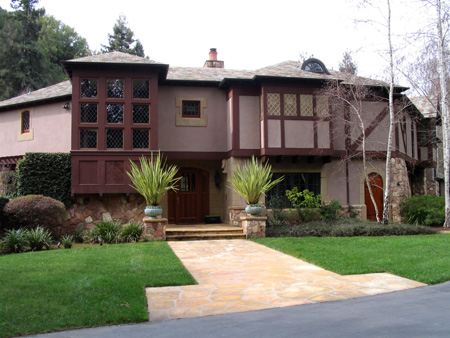
The main entrance is here.
Courtesy Ralston
Independent Works
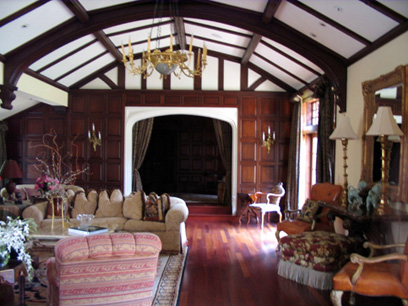 Inside left of the main entrance is a large living room in Tudor
style, preserved much as it originally appeared.
Inside left of the main entrance is a large living room in Tudor
style, preserved much as it originally appeared.
Courtesy Ralston
Independent Works
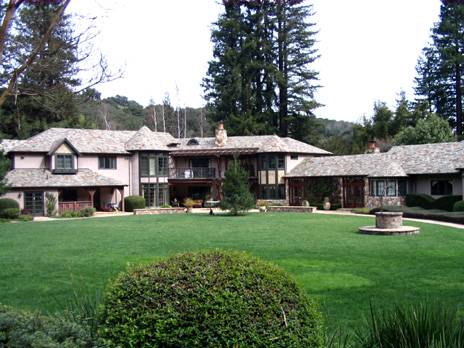 The
landscape architect's path curves around to a view of the main
house.
The
landscape architect's path curves around to a view of the main
house.
Courtesy Ralston
Independent Works
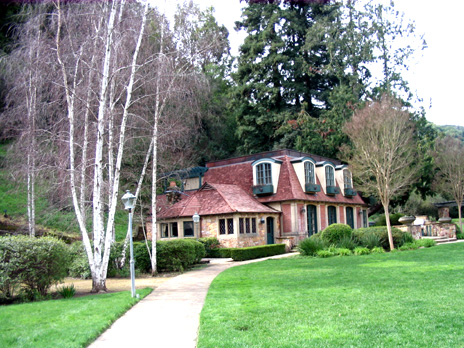 A
second story was added to the Talley Ho Restaurant, now the guest
house.
A
second story was added to the Talley Ho Restaurant, now the guest
house.
Courtesy Ralston
Independent Works
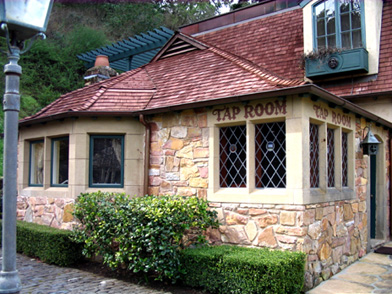
The adjoining Tap Room was retained.
Courtesy Ralston
Independent Works
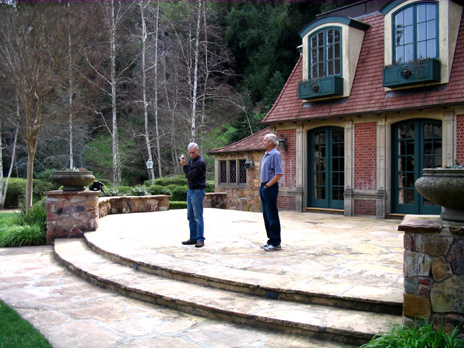
Lana got this shot of me taking the panorama as Bob Wayman looks
on. Courtesy Ralston
Independent Works
This concludes our tour. Bob Wayman generously lent, among other
things, a large scrapbook, actually more of an album, compiled
by his daughter.
